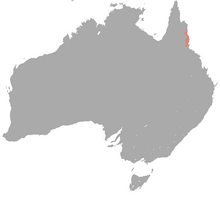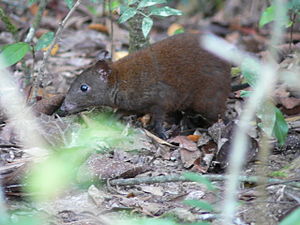| Revision as of 18:25, 5 April 2018 editTrappist the monk (talk | contribs)Administrators479,996 editsm →top: lang fix; using AWB← Previous edit | Revision as of 12:48, 26 September 2018 edit undoFalconfly (talk | contribs)Extended confirmed users3,356 edits Scales are apparently not ancestral to synapsids. If they were there's still a massive gulf of fully furred mammals and archaic putative scaled synapsids. On top of that this isn't even source. Pathetic.Next edit → | ||
| Line 33: | Line 33: | ||
| It moves by extending its body and then bringing both of its hind legs forward, and uses an opposable digit on the hind foot to climb trees.<ref name=diet/> | It moves by extending its body and then bringing both of its hind legs forward, and uses an opposable digit on the hind foot to climb trees.<ref name=diet/> | ||
| ==Living fossil== | |||
| The rat-kangaroo has a number of unusual traits that are seen as linking it to more primitive marsupial ancestors. For example, it has reptile-like scales on its feet and tail, engages in a more primitive hopping behavior than most of its kangaroo cousins, and 5 toes on each foot. | |||
| ==References== | ==References== | ||
Revision as of 12:48, 26 September 2018
| Musky rat-kangaroo | |
|---|---|

| |
| Conservation status | |
 Least Concern (IUCN 3.1) | |
| Scientific classification | |
| Kingdom: | Animalia |
| Phylum: | Chordata |
| Class: | Mammalia |
| Infraclass: | Marsupialia |
| Order: | Diprotodontia |
| Suborder: | Macropodiformes |
| Family: | Hypsiprymnodontidae |
| Genus: | Hypsiprymnodon Ramsay, 1876 |
| Species: | H. moschatus |
| Binomial name | |
| Hypsiprymnodon moschatus Ramsay, 1876 | |

| |
| Musky rat-kangaroo range | |
The musky rat-kangaroo (Hypsiprymnodon moschatus) is a marsupial species found only in the rainforests of northeast Australia. Although some scientists place this species as a subfamily (Hypsiprymnodontinae) of the family Potoroidae, the most recent classification places it in the family Hypsiprymnodontidae with prehistoric rat-kangaroos.
The generic name combines the Ancient Greek hyps- (‘high’), prymnos (πρυμνός ‘hindmost’), and ]] Error: {{Transliteration}}: transliteration text not Latin script (pos 8) (help) (‘teeth’). Its specific name, moschātus, is scientific Latin for ‘musk’.


It is the smallest macropod that is quadrupedal and only diurnal. The musky rat-kangaroo is about 21 to 34 cm long with a 6.5- to 12.3-cm-long hairless tail, weighs between 332 and 680 g, and eats fallen fruit and large seeds, as well as small invertebrates.
It moves by extending its body and then bringing both of its hind legs forward, and uses an opposable digit on the hind foot to climb trees.
References
- Groves, C. P. (2005). Wilson, D. E.; Reeder, D. M. (eds.). Mammal Species of the World: A Taxonomic and Geographic Reference (3rd ed.). Baltimore: Johns Hopkins University Press. p. 56. ISBN 0-801-88221-4. OCLC 62265494.
- Template:IUCN2008
- "Hypsiprymnodon". Merriam-Webster.com Dictionary. Merriam-Webster. Unabridged (subscription required)
- Nowak, Ronald M. (2005) Walker's Marsupials of the World. Baltimore, USA: The Johns Hopkins University Press. pp. 149-150. ISBN 0-8018-8222-2.
- ^ McKay, G. (Ed.). (1999). Mammals (p. 60). San Francisco: Weldon Owen Inc. ISBN 1-875137-59-9
External links
- Chambers Wildlife Rainforest Lodges
- Australian Natural History Safari
- Pictures and facts about the musky rat-kangaroo
| Taxon identifiers | |
|---|---|
| Hypsiprymnodon moschatus |
|
This article about a diprotodont is a stub. You can help Misplaced Pages by expanding it. |